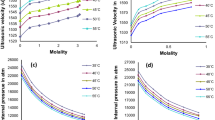Abstract
Eutectic MgF2-CaF2 based salt containing YF3, CaO and Al2O3 additions were used in this study. The electrical conductivity was measured as a function of temperature by a calibration-free coaxial electrode setup. The materials selection and setup design were optimized to accurately measure the electrical conductivity of the highly conductive molten salts (>1 S/cm). The solubility and diffusion behavior of alumina and zirconia in the molten salts were investigated by drawing and holding the molten salt for different lengths of time within capillary tubes made of alumina and zirconia, respectively. After the time-dependent high temperature holds, the samples were cooled and the solubility of the solute within the molten salt was determined using scanning electron microscopy, energy-dispersive X-ray spectroscopy analysis and wavelength-dispersive X-ray spectroscopy analysis.
Access this chapter
Tax calculation will be finalised at checkout
Purchases are for personal use only
Preview
Unable to display preview. Download preview PDF.
Similar content being viewed by others
References
G. Locatelli, M. Mancini, and N. Todeschini,“Generation IV nuclear reactors: Current status and future prospects,” Energy Policy, vol. 61, pp. 1503–1520,2013.
H. Zhu,“Rare Earth Metal Production by Molten Salt Electrolysis,” in Encyclopedia of Applied Electrochemistry, G. Kreysa, K. Ota, and R. F. Savinell, Eds. New York, NY: Springer New York, 2014, pp. 1765–1772.
K. Maeda, K. Yasuda, T. Nohira, R. Hagiwara, and T. Homma,“Silicon Electrodeposition in Water-Soluble KF-KC1 Molten Salt: Investigations on the Reduction of Si(IV) Ions,” J. Electrochem. Soc, vol. 162, no. 9, pp. D444-D448, Jun. 2015.
R. Lumley, Ed., Fundamentals of Aluminium Metallurgy. Woodhead Publishing Limited, 2011.
U. B. Pal, D. E. Woolley, and G. B. Kenney,“Emerging SOM technology for the green synthesis of metals from oxides,” JOM, vol. 53, no. 10, pp. 32–35, Oct. 2001.
A. Krishnan, U. B. Pal, and X. G. Lu,“Solid oxide membrane process for magnesium production directly from magnesium oxide,” Metall. Mater. Trans. B, vol. 36, no. 4, pp. 463–173, Aug. 2005.
X. Guan, U. B. Pal, S. Gopalan, and a. C. Powell,“LSM (La0.8Sr0.2MnO3- )-Inconel Inert Anode Current Collector for Solid Oxide Membrane (SOM) Electrolysis,” J. Electrochem. Soc, vol. 160, no. 11, pp. F1179-F1186, Sep. 2013.
E. S. Gratz, X. Guan, J. D. Milshtein, U. B. Pal, and A. C. Powell,“Mitigating Electronic Current in Molten Flux for the Magnesium SOM Process,”Metall. Mater. Trans. B, vol. 45, no. 4, pp. 1325–1336, Aug. 2014.
X. Guan, U. B. Pal, and A. C. Powell,“Energy-Efficient and Environmentally Friendly Solid Oxide Membrane Electrolysis Process for Magnesium Oxide Reduction: Experiment and Modeling,” Metall. Mater. Trans. E, vol. 1, no. 2, pp. 132–144, Jun. 2014.
M. Suput, R. Delucas, S. Pati, G. Ye, U. Pal, and A. C. Powell IV,“Solid oxide membrane technology for environmentally sound production of titanium,” Miner. Process. Extr. Metall, vol. 117, no. 2, pp. 118–122, Jun. 2008.
A. Krishnan, X. G. Lu, and U. B. Pal,“Solid Oxide Membrane (SOM) technology for environmentally sound production of tantalum metal and alloys from their oxide sources,” Scand. J. Metall., vol. 34, no. 5, pp. 293–301, 2005.
Y. Jiang, J. Xu, X. Guan, U. B. Pal, and S. N. Basu,“Production of Silicon by Solid Oxide Membrane-Based Electrolysis Process,” MRS Proc, vol. 1493, pp. MRSF12–1493-E19–89, Jan. 2013.
X. Guan, S. Su, U. B. Pal, and A. C. Powell,“Periodic Shorting of SOM Cell to Remove Soluble Magnesium in Molten Flux and Improve Faradaic Efficiency,” Metall. Mater. Trans. B, vol. 45, no. 6, pp. 2138–2144, Dec. 2014.
U. B. Pal and A. C. Powell,“The use of solid-oxide-membrane technology for electrometallurgy,” JOM, vol. 59, no. 5, pp. 44–19, May 2007.
C. J. Macdonald,“Calibration-Free Electrical Conductivity Measurements For Highly Conductive Slags,” Boston University, 2000.
S. L. Schiefelbein, N. A. Fried, K. G. Rhoads, and D. R. Sadoway,“A high-accuracy, calibration-free technique for measuring the electrical conductivity of liquids,” Rev. Sci. Instrum., vol. 69, no. 9, p. 3308, 1998.
S. L. Schiefelbein and D. R. Sadoway,“A high-accuracy, calibration-free technique for measuring the electrical conductivity of molten oxides,” Metall. Mater. Trans. B, vol. 28, no. 6, pp. 1141–1149, Dec. 1997.
U. B. Pal,“Determining physio-chemical properties of slags by electrical measurements,” JOM, vol. 54, no. 11, pp. 57–61, Nov. 2002.
K. R. Cooper and M. Smith,“Electrical test methods for on-line fuel cell ohmic resistance measurement,” J. Power Sources, vol. 160, no. 2, pp. 1088–1095, 2006.
S. C. Britten and U. B. Pal,“Solid-state amperometric sensor for the In-situ monitoring of slag composition and transport properties,” Metall. Mater. Trans. B, vol. 31, no. 4, pp. 733–753, 2000.
E. S. Gratz, J. D. Milshtein, and U. B. Pal,“Determining Yttria-Stabilized Zirconia (YSZ) Stability in Molten Oxy-Fluoride Flux for the Production of Magnesium with the SOM Process,” J. Am. Ceram. Soc, vol. 96, no. 32300, pp. 3279–3285, Jun. 2013.
J. Xu, B. Lo, Y. Jiang, U. Pal, and S. Basu,“Stability of yttria stabilized zirconia in molten oxy-fluorite flux for the production of silicon with the solid oxide membrane process,” J. Eur. Ceram. Soc, vol. 34, no. 15, pp. 3887–3896, Dec. 2014.
J. D. Edwards, C. S. Taylor, L. A. Cosgrove, and A. S. Russell,“Electrical Conductivity and Density of Molten Cryolite with Additives,” J. Electrochem. Soc, vol. 100, no. 11, p. 508, 1953.
Author information
Authors and Affiliations
Editor information
Editors and Affiliations
Rights and permissions
Copyright information
© 2016 TMS (The Minerals, Metals & Materials Society)
About this paper
Cite this paper
Su, S., Villalon, T., Pal, U., Powell, A. (2016). Techniques for Measuring Solubility and Electrical Conductivity in Molten Salts. In: Reddy, R.G., Chaubal, P., Pistorius, P.C., Pal, U. (eds) Advances in Molten Slags, Fluxes, and Salts: Proceedings of the 10th International Conference on Molten Slags, Fluxes and Salts 2016. Springer, Cham. https://doi.org/10.1007/978-3-319-48769-4_49
Download citation
DOI: https://doi.org/10.1007/978-3-319-48769-4_49
Publisher Name: Springer, Cham
Print ISBN: 978-3-319-48625-3
Online ISBN: 978-3-319-48769-4
eBook Packages: Chemistry and Materials ScienceChemistry and Material Science (R0)




